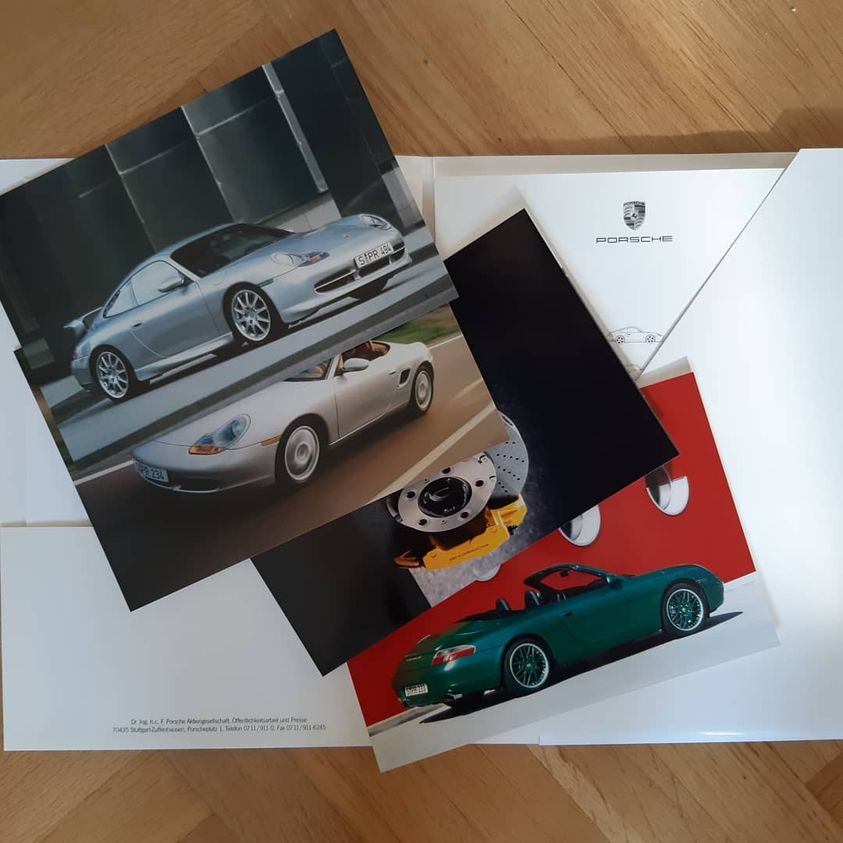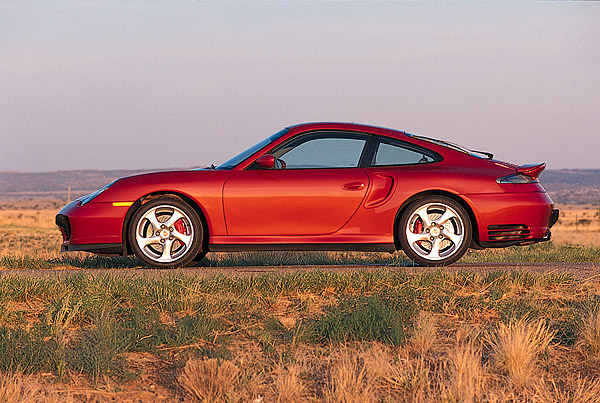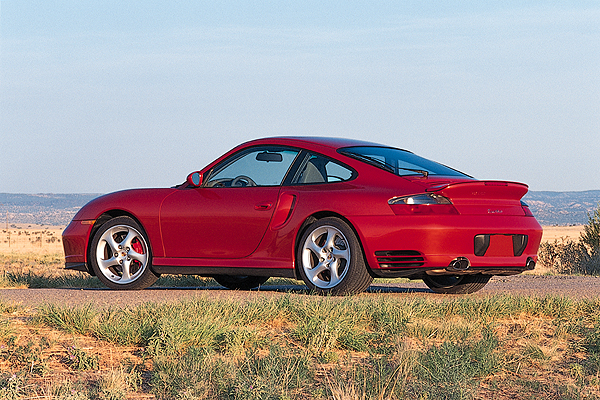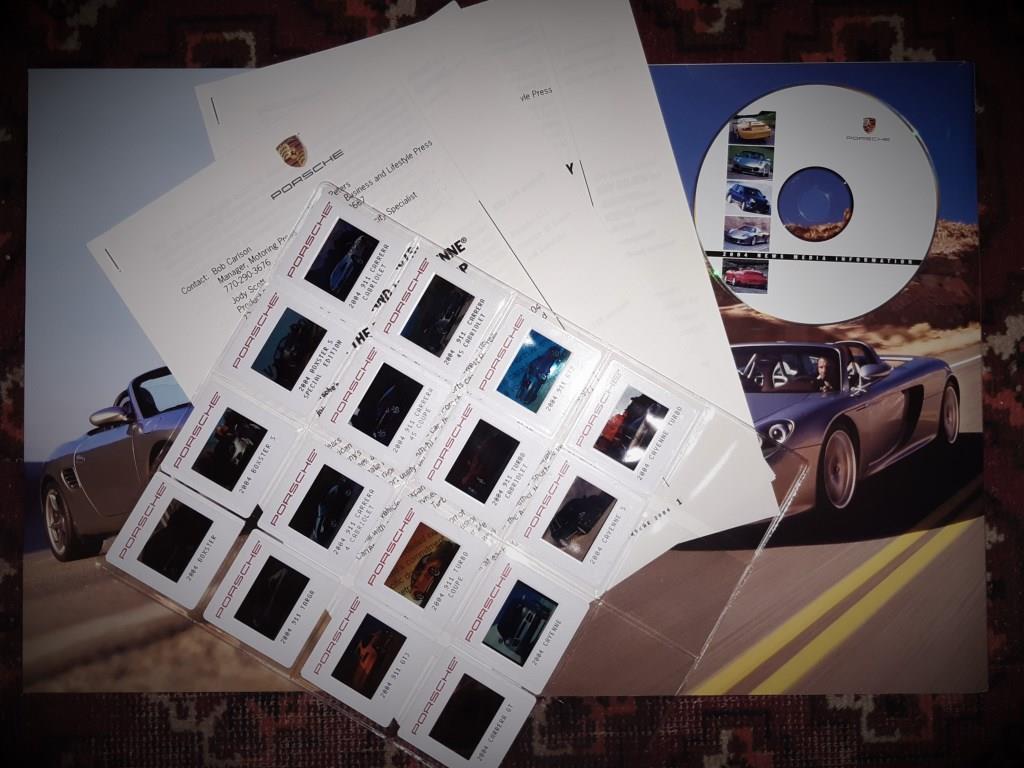
Porsche Press kit 2000

From the first 911™ Turbo, this top Porsche model has always stood apart from other Porsche 911 models by virtue of functional design differences. Nothing has ever been added that didn’t serve a purpose, and nothing has ever been tacked on for the sake of appearance. From that purpose-driven design evolved a distinctive “Turbo look,” highlighted by widely flared fenders, a widened rear stance, and a distinctive rear spoiler.
That the function-driven design has created the most recognizable supercar shape in the world is just a coincidence.
The 2001 911 Turbo continues that tradition and stands apart from the 911 Carrera models with all-new front and rear styling and a wider stance. In front, the 911 Turbo features unique bi-xenon headlight clusters that use xenon high-intensity discharge headlights for both the low and high beams.
Three large intake grills dominate the lower front fascia and provide cooling air to the car’s three radiators. Together, the three radiators provide 50 percent more cooling surface than in the 911 Carrera 4. Underside guide plates in the middle and on the sides prevent the warm air exiting the radiators from causing axle lift. The front spoiler reduces airflow under the car, helping to reduce axle lift force. Two intakes in the spoiler supply cooling air to the brakes through ducts.
At the rear, Porsche widened the 911 Turbo by 2.6 inches (65 mm) to accommodate the 18-inch alloy wheels and massive 295/30 ZR18 tires. The Turbo-trademark red-painted alloy brake calipers are plainly visible through the wheel spokes. The widened rear quarter panels also place the intercooler intakes into the air stream. Compared to the Carrera 4, the 911 Turbo rear track is wider by 1.57 inches (40 mm).
Louvers in the lower rear fascia vent air from the engine compartment. A different taillight design from the 911 Carrera 4 further distinguishes the 2001 911 Turbo.
Porsche has replaced a fixture of 911 Turbo design since the first model – the “whale tail” spoiler. Used first as an aerodynamic aid and to vent the engine compartment, the wing later grew to help house the engine intercooler. Since the 2001 911 Turbo houses its intercoolers behind the rear wheels, Porsche aerodynamicists designed a more subtle spoiler. The new two-piece rear wing resembles the “ducktail” spoiler first seen on Porsche Carrera models of the early 1970s. The resemblance ends when the upper part automatically raises at speeds above 75 mph (120 km/h) to prevent lift force on the rear axle. The wing retracts when car speed drops below 50 mph (80 km/h). At the car’s top track speed of 189 mph (308 km/h), the wing adds 20 pounds (9 kg.) of downforc e .
A smooth underbody design and various underbody panels guide airflow under the car to reduce drag and lift. In front and rear, small, flexible spoiler lips at the front of the wheel arches also help reduce drag and lift. The rear underbody cover guides airflow to the back of the car without impeding heat dissipation or access to the powertrain. Despite the wider stance compared to the 911 Carrera 4, the 2001 911 Turbo meets the air with an impressive 0.31 coefficient of drag (Cd), compared to 0.30 for the 911 Carrera 4.
The Bi-xenon headlights that give the 2001 911 Turbo such a distinctive look also introduce the world’s first use of this high-intensity gas-discharge technology to provide both low and high beams. Other systems, including the Litronic xenon lights on other Porsche models, provide xenon lights for the low beams only.
The bi-xenon lights provide both low and high beams from a single gas-discharge bulb and project light through a 70-mm lens. A moving mask provides the different light distribution required for low/high beams. When raised, the mask allows enough light to pass to create the low beam. Lowering the mask opens a greater path for the light to create a high beam effect while maintaining the bright/dark barrier required by law. The mask moves in a fraction of a second, allowing a high beam flasher function.
The standard headlight washer system uses high-pressure spray nozzles integrated into the headlight clusters. The closeness of the nozzles to the lenses makes the spray more effective than before.
The 2001 911 Turbo comes with the peace of mind of a four-year/50,000-mile (80,000 kilometer), bumper-to-bumper limited warranty, which includes Porsche’s roadside assistance program. The galvanized body and 26-step paint and anti-corrosion process enable Porsche to warrant each car against rust perforation for 10 years and unlimited mileage. In addition, Porsche guarantees the paint finish for three years – also without a mileage limitation.

The 911 Turbo provides 2+2 seating, and the individually folding rear seats provide a versatile space for luggage. The 911 Turbo shares its basic interior design with the 911 Carre r a® 4 but adds many enhancements and standard luxury features over and above the standard equipment in that model, including:
The ignition key integrates the remote entry control and allows the driver to open the luggage compartment lid and operate the seat memory function.
Standard equipment shared with the 911 Carrera 4 includes:
Owners of previous 911 or 911 Turbo models will feel right at home with the ignition switch to the left of the steering wheel and the gas pedal pivoted from the floor. Porsche broke with previous 911 Turbo tradition, however, and suspended the brake and clutch pedals from the dashboard instead of the floor.
The large center instrument pod houses the tachometer, the lower middle portion of which includes the display screen for the standard onboard computer. The dot matrix display shows turbo boost and basic settings including total and trip mileage. In addition, the driver can call up oil level, exterior temperature, fuel consumption and estimated driving range – 35 alerts in all.
The analog speedometer to its left includes a small digital speed readout. The far-left gauge contains a battery gauge. The pod to the right of the tachometer contains the coolant temperature gauge, fuel gauge and oil level indicator. On Tiptronic®-equipped cars, this pod also includes the gear indicator. The rightmost pod contains an oil pressure gauge.
Porsche designers discretely placed light-emitting diode (LED) orientation lights in the cabin to provide soft flood lighting for certain controls. One LED integrated within the main interior light softly lights the entire cockpit and center console. This LED provides just enough light to help the driver more easily find controls at night, but does not distract as the main white light would if turned on. The driver can adjust the light level between two settings.
Another LED housed in the left door handle casts a beam onto the ignition and light switch area. One yellow LED in each door recess helps the driver and passenger easily locate the door handles.
The center console houses the climate control and stereo system. On cars equipped with the optional Porsche Communication Management (PCM) system, the PCM screen and control panel occupy the upper section of the console, and the climate control system occupies the lower section. The PCM integrates Global Positioning Satellite (GPS) navigation and the climate control system.
For precise navigation, the PCM uses navigation maps on CD-ROM discs (produced by Navigation Technologies) and a GPS antenna mounted in the dashboard, wheel speed sensors and a gyroscope. The system reads directions aloud and displays the car’s pro g ress via onscreen maps. The driver or passenger can enter specific addresses or various points of interest.
Porsche Cars North America offers customers in the United States and Canada the opportunity to personalize their cars through two option-selection channels. Together with the choice of limited-availability special paint colors, the special options allow a customer to make a Porsche into a truly one-of-a-kind car. The Porsche Exclusive program offers a wide array of optional features ins
talled at the factory. Options include custom interior trim packages and individual trim items. The Porsche four-year/50,000 mile bumper-to-bumper warranty covers all Exclusive options, and Porsche dealers can include the cost of the options in the lease or finance contract.
The Tequipment (“Tech-quipment”) program offers a line of accessories available only from authorized Porsche dealers. Tequipment options include such items as special wheels, aerobody kits, instrument panel trim kits, CD changers, and custom floormats. Customers can order Tequipment options at the time of purchase, or return to the dealership for installation later.
While installation of Tequipment may require some modifications to the car, such modifications do not affect the standard limited warranty. Tequipment items come with a two-year warranty when installed by a certified technician at an authorized Porsche dealership.

Porsche Press kit 2000

Porsche Press kit 2004 - USA

Porsche Press kit

Porsche Literature

Our Porsche Cars